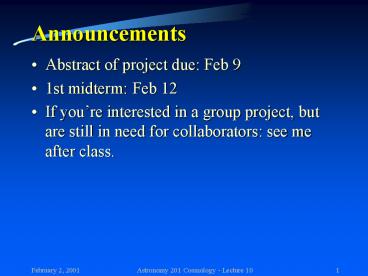Announcements - PowerPoint PPT Presentation
1 / 16
Title:
Announcements
Description:
Bessel (1838): measured the first parallax of a star (61 Cygni). Result: 0.3' ... 1 parsec (1pc) is the distance that produces a parallax. shift of 1' or ... – PowerPoint PPT presentation
Number of Views:46
Avg rating:3.0/5.0
Title: Announcements
1
Announcements
- Abstract of project due Feb 9
- 1st midterm Feb 12
- If youre interested in a group project, but are
still in need for collaborators see me after
class.
2
Tutoring
- Location Steward room 208
- Tutors
- Ariane Lee
- Mon, Wed, Fri 1015-1115
- Thu 130-330
- Andrea Urban
- Tue, Thu 1130-130
- Shanna Shaked
- Mon, Wed 400-500
- Tue 200-500
3
Lecture 10History of Cosmology IV Determining
the Size and Age of the Universe
4
Size of the Universe I
- Size of the Earth
- radius 6370 km
- Eratosthenes (200 B.C.)
- Size of the solar system
- several billion km
- rough idea Aristarchus (250 B.C.)
- detailed layout 1750
5
Size of the Universe II
- Distance to the stars
- until 1838 far away
- Bessel (1838) measured the first parallax of a
star (61 Cygni). Result 0.3 - So how far is 61 Cygni ? Recall d D ? q
- d diameter of Earths orbit (149.7 million km)
- D distance of 61 Cygni
- q parallax (0.3)
6
Distance of 61 Cygni
- So lets plug in numbers ...
- But dont forget to transform angles into radians
!!! - 0.3 0.3/3600 8.3?10-5 º
- into radians 8.3?10-5 º ? ?/180 1.45 ?10-6
- put into formula D 149.7 ?106 km/1.45 ?10-6
? 1014 km - for comparison 1 light year (LY) 1 LY 300
000 km/s ? 86400 s/d ? 365 d/yr 9.5 ?1012 km
7
Astronomers favorite length unit
1 parsec (1pc) is the distance that produces a
parallax shift of 1 or 1 parsec (1pc) is the
distance under which the radius of the Earths
orbit around the Sun spans an angle of 1
- Distance in pc 1/parallax in
- 1 pc 3.26 LY
8
Shape and Size of the Milky Way
- 1600 Galileo MW collection of stars
- 1750 Immanuel Kant, Thomas WrightMW is a disk
- 1780 Herschel counted stars in 700 fields
around the sky MW is flattened 41, Sun is near
the centerbut is it ?
9
Size of the Milky Way
- Kapteyn (1920)
- measures distances to stars in the MW
- conclusion
- MW about 5 kpc across
- Sun near the center
- Shapley (1920)
- measured distances to globular clusters
- conclusion
- MW about 100 kpc across
- Sun 20 kpc off center
Solution ???
10
Nature of spiral nebulae ?
- Curtis
- MW is 10 kpc across
- Sun near center
- spiral nebulae were other galaxies
- high recession speed
- apparent sizes of nebulae
- did not believe van Maanens measurement
- ? Milky Way one galaxy among many others
- Shapley
- MW is 100 kpc across
- Sun off center
- spiral nebulae part of the Galaxy
- apparent brightness of nova in the Andromeda
galaxy - measured rotation of spirals (via proper motion)
by van Maanen - ? Milky Way Universe
11
Solution I
- Role of dust
- obscuration Kapteyn/Curtis could only see a
small fraction of the Milky Way disk - dimming stars appear to be dimmer ? Shapley,
ignoring dust, concluded that globular clusters
are farther away than they actually are. - ? Milky Way is 30 kpc across, Sun is 8.5 kpc off
center.
12
(No Transcript)
13
Solution II
- Van Maanens observation (rotation of spiral
nebulae) turned out to be wrong. - There is a difference between novae and
supernovae, supernovae are much brighter?
Andromeda is farther away than anticipated by
Shapley - ? spiral nebulae are galaxies like the Milky Way.
Distance millions of parsec.
14
Age of the Earth I
- Before 1670 little attention, but common
perception that the Earth is young - 1669 Nicolaus Steno older rocks below, younger
rocks above. Layering of rocks ? age sequence - 1800 Realization that Earth may be very old
- 1858 Wallace and Darwin Evolution of species ?
Earth must be very old (hundreds of million of
years)
15
Age of the Earth II
- Problem in the 19 century, the Sun was believed
to be only 100 million years old (it would run
out of fuel otherwise) - Solution nuclear fusion (Eddington-Bethe-Weizsäck
er 1930s) - Today radioactive dating of rocks ? Earth (and
solar system) is 4.6 billion years old - later in this class age of the universe 14
billion years
16
Announcements
- Abstract of project due Feb 9
- 1st midterm Feb 12
- If youre interested in a group project, but are
still in need for collaborators see me after
class.































